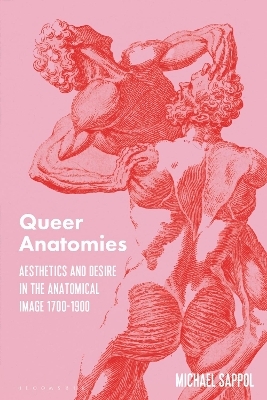
Queer Anatomies
Bloomsbury Visual Arts (Verlag)
978-1-350-40086-3 (ISBN)
As a foundational subject for physicians, surgeons and artists in 18th- and 19th-century Europe, anatomy was a privileged, male-dominated domain. Artistic and medical competence depended on a deep knowledge of anatomy and offered cultural legitimacy, healing authority, and aesthetic discernment to those who practiced it. The anatomical image could serve as a virtual queer space, a private or shared closet, or a men’s club. Serious anatomical subjects were charged with erotic, often homoerotic, undertones.
Taking brilliant works by Gautier Dagoty, William Cheselden, and Joseph Maclise, and many others, Queer Anatomies assembles a lost archive of queer expression—115 illustrations, in full-colour reproduction—that range from images of nudes, dissected bodies, penises, vaginas, rectums, hands, faces, and skin, to scenes of male viewers gazing upon works of art governed by anatomical principles. Yet the men who produced and savored illustrated anatomies were reticent, closeted. Diving into these textual and representational spaces via essayistic reflection, Queer Anatomies decodes their words and images, even their silences. With a range of close readings and comparison of key images, this book unearths the connections between medical history, connoisseurship, queer studies, and art history and the understudied relationship between anatomy and desire.
Michael Sappol is Visiting Researcher at Uppsala University, Sweden, and a historian of the visual culture and performance of medicine and science, with a focus on anatomy and the Body. Between 1998 and 2016, he was Historian, Scholar-in-Residence and Exhibition Curator at the National Library of Medicine, USA.
List of Illustrations
Acknowledgements
Part One: The unbearable queerness of anatomy
Introduction
1.1.1 A queer ventriloquism act
1.1.2 An advisory, an acknowledgment
Theory
1.2.1 Queer explains everyone
1.2.2 Queer history
1.2.3 The gaze and its objects
1.2.4 Proliferating views, intensified viewing
1.2.5 An odd term
1.2.6 Default genders of anatomy
1.2.7 Homoerotics queered
1.2.8 The epistemology of the anatomical closet
Objects
1.3.1 Mystery men, mute images
1.3.2 The mystery penis
1.3.3 The penis and medical eyes
1.3.4 The closet’s edge
Part Two: Connoisseurship, taste and “the beauty of the plate”
Gautier
2.1.1 Hungry eyes, science and the anatomical mezzotint
2.1.2 Anatomical provocations and the senses
Cheselden
2.2.1 “The beauty of the plate”
2.2.2 What is beautiful?
2.2.3 Connoisseurial judgment and anatomy
2.2.4 Cheselden’s figures
2.2.5 Cheselden the man
2.2.6 The learning curve
2.2.7 Headbutting disputation
Between Men
2.3.1 Between men: connoisseurs, collectors and anatomy
2.3.2 Conversations and “conversation pieces”
2.3.3 Eyes on the connoisseurial gaze
2.3.4 Between men: a continuum of attachments
2.3.5 Between men: surgical masculinity and objects
Part Three: “Overshadowed by the artist”: Mr Joseph Maclise’s queer anatomy
Prologue: Nicolas-Henri Jacob
3.1 Medical eyes, surgical hands
Joseph Maclise
3.2 The mystery of Mr Joseph Maclise
3.2.1 Misters Quain and Maclise
3.2.2 Queer bedroom scenes
3.2.3 Irrelevant penises (a gallery)
3.2.4 Touching representation
3.2.5 Cascading rhymes
3.2.6 The anus compared
3.2.7 Maclise’s men: An imaginary confraternity?
3.2.8 Race and Maclise’s radical (queer) philosophy of universalist embodiment
3.2.9 Heteronormative queer
3.2.10 A crucifixion
3.2.11 How did Quain and Maclise get on?
3.2.12 Comparative anatomies: predecessors, contemporaries
3.2.13 The queer figure study
3.2.14 The locked atlas and locked closet
Appendix
3.3 Maclise’s long goodbye
Conclusion: The ontology of the anatomical closet
Bibliography
Index
| Erscheinungsdatum | 05.10.2024 |
|---|---|
| Zusatzinfo | 113 colour illus |
| Verlagsort | London |
| Sprache | englisch |
| Maße | 156 x 234 mm |
| Themenwelt | Kunst / Musik / Theater ► Allgemeines / Lexika |
| Kunst / Musik / Theater ► Kunstgeschichte / Kunststile | |
| Kunst / Musik / Theater ► Malerei / Plastik | |
| Studium ► 1. Studienabschnitt (Vorklinik) ► Anatomie / Neuroanatomie | |
| ISBN-10 | 1-350-40086-6 / 1350400866 |
| ISBN-13 | 978-1-350-40086-3 / 9781350400863 |
| Zustand | Neuware |
| Haben Sie eine Frage zum Produkt? |
aus dem Bereich


